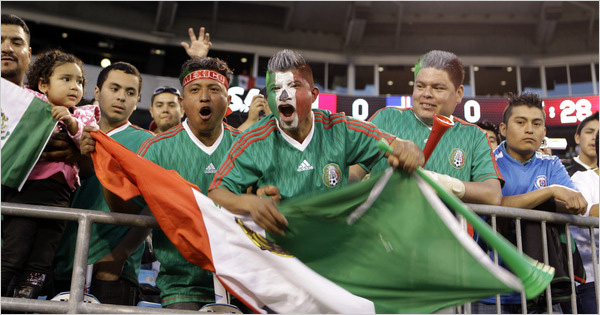
|  |  |  Americas & Beyond Americas & Beyond  
Most Popular Soccer Team in the U.S.: Mexico?
 Billy Witz - New York Times Billy Witz - New York Times
go to original
May 07, 2010


| | In March, 63,227 fans at Bank of America Stadium in Charlotte, N.C., watched a 0-0 tie between Mexico and Iceland. (Chuck Burton/Associated Press) |  |
In late 1993, buoyed by having qualified for the World Cup in the United States the next year, Mexico stepped outside its usual sites — Los Angeles, Chicago, Dallas and New York — to play an exhibition game in San Diego.

Promoters, who had never attracted more than 20,000 fans to a soccer game unaccompanied by a concert, would have been thrilled to hit that mark on a midweek night game against China.

But when the game arrived, they were overwhelmed. Traffic heading north from the border on Interstate 805 was backed up for miles, and as kickoff approached, people began to park on the side of the road. They walked down embankments and through a creek and dashed across streets to reach Jack Murphy Stadium. Once there, long lines snaked from ticket windows.

When the crowd finally settled in, shortly after halftime, nearly 50,000 people filled the stadium.

“That game, in a way, opened the eyes of the Mexican national team and promoters of what was possible if you took risks,” said Paul Mendes, who has been involved with organizing Mexico’s games in the United States for much of the last two decades. “It set off a wave.”

That wave is growing. Mexico’s trips to the United States, including Friday night’s sold-out exhibition against Ecuador at the new 75,000-seat stadium in the Meadowlands in New Jersey, are big business.

Mexico will play Senegal at Soldier Field in Chicago on Monday and Angola at Reliant Stadium in Houston on Thursday. By the end of the tour, which is to prepare Mexico’s players for the World Cup, the team known as El Tricolor will have played six games in the United States in less than three months, almost all before capacity crowds.

When Mexico played New Zealand at the Rose Bowl in Pasadena, Calif., in March, the only game in which European-based players performed, 90,000 packed the Rose Bowl on a Wednesday night. It was easy to see what brings Mexico back.

Not just the sheer numbers of fans, many of whom paid more than $40 for tickets — about double what tickets would cost in Mexico — but also in the hours leading up to the game, the bustling fiesta that surrounded the stadium had the air of a carnival with face painting, lucha libre acts, bands and games.

It was a far different atmosphere a decade ago, when Mexico’s games drew a typically young and overwhelmingly male crowd. The crowd now is dotted with women and families, and loutish behavior has waned.

It was a quintessential American scene — except that the language of choice was Spanish.

“It’s a nation within a nation,” said Doug Logan, the chief executive of USA Track and Field and a former Major League Soccer commissioner. “The crowd is more affluent now and the normal tipoff is that there are more women. When it becomes more affluent, it is safer for them to come.”

It is not surprising that a more wholesome environment would be attractive to businesses. Mexico’s visits to the United States have 14 major sponsors, including the Home Depot, Coca-Cola, AT&T and Wrigley.

Georgiana Flores, the director of multicultural marketing and sponsorship for Allstate insurance, a sponsor of the Mexico national team in the United States for four years, said that soccer was the best vehicle to reach many Mexican-Americans.

“The passion that Hispanics, and Mexicans in particular, have for soccer can’t be matched by anything else,” said Flores, whose company does not do business in Mexico. “The Mexican national team has been our targeted sports property.”

Television ratings reflect this. ESPN2’s broadcast of the United States’ victory against Mexico in February 2009 drew 1.2 million, the largest audience for a World Cup qualifier — but it was barely one-fifth the audience that Spanish-language Telemundo drew in the United States.

For the last seven years, Mexico’s games in the United States have been organized by Soccer United Marketing, the business arm of M.L.S. S.U.M. controls most major soccer promotional rights in the United States, including World Cup TV rights, tournaments like the Gold Cup, and the U.S. Soccer Federation. One of its most valuable agreements is with the Mexican soccer federation.

Although some wonder why M.L.S. would be in business with a competitor, Commissioner Don Garber said it fit with the league’s plan.

“Our goal is to create a soccer nation in our country,” he said. “We don’t care who they root for, who they watch on TV, who drives their passion. These exhibition games create big moments, but ultimately real fans connect with their local clubs. The Mexican national team is leaving today and it won’t come back for years. Next week the Red Bulls are going to have a game at brand-new Red Bull Arena.”

Before its agreement with S.U.M., the Mexican federation contracted with different promoters in different markets.

“We felt like if you could professionalize, you could use it as a platform to sponsors to sell their products,” Garber said. “It would provide direct lines to the hearts and minds of Mexican consumers.”

That has allowed Mexico to venture successfully into other markets. In 2008, Mexico drew 56,416 in Seattle for a game with China. In 2009, El Tri attracted 51,115 when it played Venezuela in Atlanta. In March, 63,227 went to a game in Charlotte, N.C., when Mexico played Iceland.

That is why Mexico keeps coming back. In stadiums filled with fans wearing the jersey of their national team, it is hard not to notice the color — green.
|

 |
|  |



